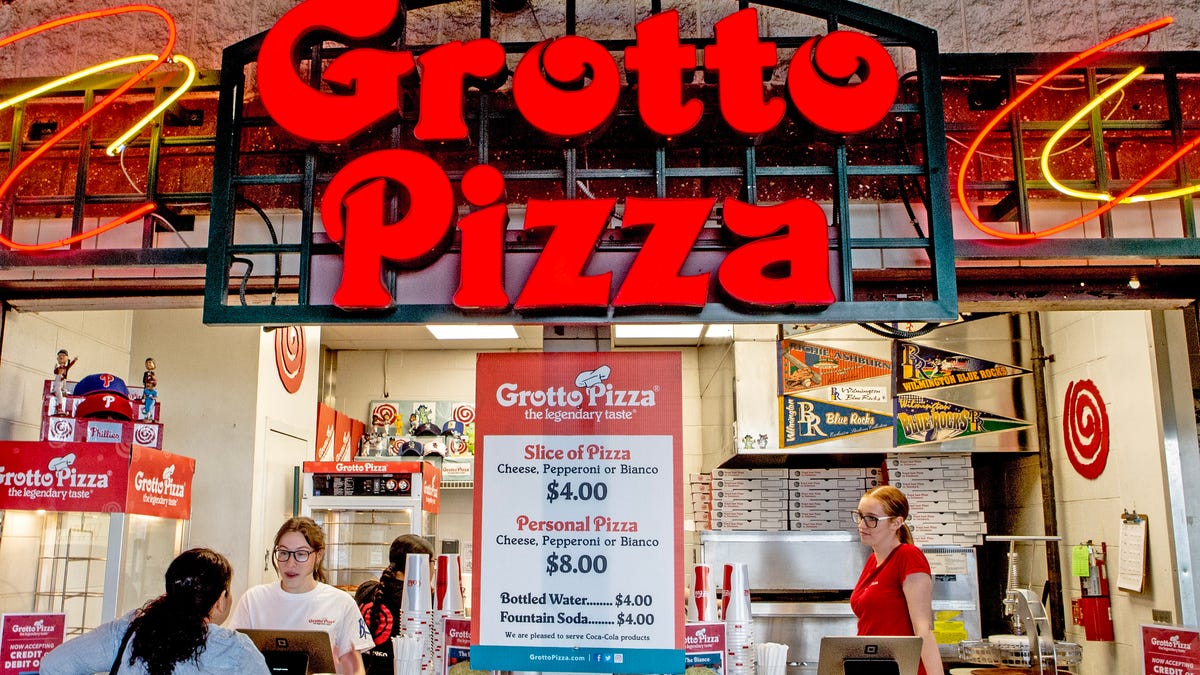Delaware
These Delaware restaurants are open on New Year’s Day. Where to dine, order in on Jan. 1

New Year’s Resolutions Therapists Encourage You to Make
Did you know nearly 80% of people who make a New Year’s resolution drop it by January 19th? Business Insider blames vague and unrealistic goals, but the Huffpost listed some simple and effective resolutions for 2024. Buzz60’s Maria Mercedes Galuppo has the story.
If holiday cooking tired you out and you plan to dine out or order in on New Year’s Eve, we don’t blame you.
To make it easier on all the Delawareans searching for what restaurants are open on New Year’s Eve 2023, we’ve compiled a list of local spots ready to cater to your dining needs over the holiday weekend.
Here’s a list of some restaurants in Delaware that will be open on Sunday, Dec. 31.
Note that this is not a comprehensive list of every open restaurant in the state. Be sure to check the hours of other establishments before you head out during the holiday.
What restaurants are open on New Year’s Eve in Delaware?
Le Cavalier will be open on New Year’s Eve for patrons with dinner reservations. Call (302) 594-3125 or visit hoteldupont.com.
Sullivan’s Steakhouse is open on New Year’s Eve from 11 a.m. to 12:30 p.m. Call 302-308-4933 or visit sullivanssteakhouse.com/wilmington.
Rosenfeld’s Jewish Delicatessen in Rehoboth Beach is open on New Year’s Eve. Call (302) 645-1700 or visit www.rosenfeldsjewishdeli.com.
Bear Diner in Bear is open on New Year’s Eve. Call (302) 322-6242 or visit beardinerde.com.
Route 40 Diner is open on New Year’s Eve. Call (302) 836-4936.
Harpoon Hanna’s is open on New Year’s Eve. Call (302) 539-3095 or visit harpoonhannasrestaurant.com.
Wilmington Diner is open on New Year’s Day. Call (302) 762-6030 or visit www.wilmingtondinerde.com.
Capriotti’s in Bear is open on New Year’s Eve until 6 p.m. Call (302) 838-8898.
Grotto Pizza in Middletown is open on New Year’s Eve. Call (302) 314-9500.
Chain restaurants open on New Year’s Day in Delaware
The following restaurants will be open on New Year’s Day. Some have limited hours while others will be operating normally.
- Outback Steakhouse.
- Applebee’s.
- KFC.
- Popeyes.
- Red Lobster.
- Red Robin.
- Chilli’s.
- Domino’s Pizza; hours vary by location.
- Hooter’s.
- Krispy Kreme.
- Buffalo Wild Wings.
- Wendy’s.
- IHOP; hours vary by location.
- Burger King; hours vary by location.
- Taco Bell; hours vary by location.
- Cracker Barrel.
- Waffle House.
- McDonald’s; hours vary by location.
- Starbucks; hours vary by location.
- Dunkin’; hours vary by location.
- Texas Roadhouse; hours vary by location.
Got a tip or a story idea? Contact Krys’tal Griffin at kgriffin@delawareonline.com.
Have you visited these areas?: Top hidden vacation spots in Delaware you should visit this winter, what to do
DE on TV in 2023: Delawareans on TV: A year in review. Check out all the Delaware appearances on TV in 2023

Delaware
Gunshot victim flags down school bus for help in Delaware

Wednesday, December 18, 2024 5:01AM
NEW CASTLE, Del. (WPVI) — A gunshot victim jumped on a school bus full of students on Tuesday while trying to seek help in New Castle, Delaware.
The shooting happened just before 4 p.m. on Old Forge Road, near Appleby Road.
The bus driver called 911 to report the incident.
Police say the victim is hospitalized at Christiana Hospital. There was no word on his condition.
No other injuries were reported.
Further details on the shooting have not been released.
Copyright © 2024 WPVI-TV. All Rights Reserved.
Delaware
Man arrested after allegedly attacking Delaware police officer

Wednesday, December 18, 2024 1:05AM
NEW CASTLE COUNTY, Del. (WPVI) — Twenty-eight-year-old Zachary Yeldell is being accused of attacking an officer in New Castle County, Delaware.
It happened around 11:14 p.m. Monday when police responded to a disturbance at Midway Plaza Apartments, which is located on the 4800 block of Old Capitol Trail.
Police say officers responded following reports of an individual yelling in the hallway and kicking an apartment door.
When officers arrived, authorities say Yeldell hit an officer repeatedly before another officer arrived and helped detain the suspect.
The injured officer was treated at a local hospital and released.
Yeldell is facing several charges, including resisting arrest with violence.
Copyright © 2024 WPVI-TV. All Rights Reserved.
Delaware
Delaware County man sentenced to four and half years in state prison

MARGARETVILLE, N.Y. (WBNG) —Delaware County District Attorney Shawn Smith announced a Margaretville man has been sentenced to State Prison for drug crimes.
The District Attorney’s Office said Dennis Fickeria, 43, of Margaretville, NY has been sentenced to four and half years in prison. Fickeria was originally charged with criminal possession of a controlled substance.
On Jan. 3rd, according to Senior Investigator Christopher Erwin and other members of the Delaware County Sheriff’s Office, they executed a search warrant at 1542 Jones Hollow Rd., Fickeria’s residence. As a result of the search, deputies found controlled substances and firearms.
On Oct. 28, the office said Fickeria appeared in court where he pled guilty to his charge. Fickeria admitted that he had possessed fentanyl intending to sell it. The office said the guilty plea was entered as part of a negotiated disposition.
In addition to the sentencing, the office said Delaware County Court Judge John Hubbard ordered Fickeria to be supervised by the Department of Parole for one year following his release.
The office said the court also forfeited the U.S. currency seized from Fickeria’s residence which it will use to fund law enforcement efforts in Delaware County.
Copyright 2024 WBNG. All rights reserved.
-

 Business1 week ago
Business1 week agoOpenAI's controversial Sora is finally launching today. Will it truly disrupt Hollywood?
-

 Politics5 days ago
Politics5 days agoCanadian premier threatens to cut off energy imports to US if Trump imposes tariff on country
-
/cdn.vox-cdn.com/uploads/chorus_asset/file/25782636/247422_ChatGPT_anniversary_CVirginia.jpg)
/cdn.vox-cdn.com/uploads/chorus_asset/file/25782636/247422_ChatGPT_anniversary_CVirginia.jpg) Technology6 days ago
Technology6 days agoInside the launch — and future — of ChatGPT
-
/cdn.vox-cdn.com/uploads/chorus_asset/file/25789444/1258459915.jpg)
/cdn.vox-cdn.com/uploads/chorus_asset/file/25789444/1258459915.jpg) Technology4 days ago
Technology4 days agoOpenAI cofounder Ilya Sutskever says the way AI is built is about to change
-

 Politics4 days ago
Politics4 days agoU.S. Supreme Court will decide if oil industry may sue to block California's zero-emissions goal
-
/cdn.vox-cdn.com/uploads/chorus_asset/file/25546252/STK169_Mark_Zuckerburg_CVIRGINIA_D.jpg)
/cdn.vox-cdn.com/uploads/chorus_asset/file/25546252/STK169_Mark_Zuckerburg_CVIRGINIA_D.jpg) Technology5 days ago
Technology5 days agoMeta asks the US government to block OpenAI’s switch to a for-profit
-

 Politics6 days ago
Politics6 days agoConservative group debuts major ad buy in key senators' states as 'soft appeal' for Hegseth, Gabbard, Patel
-

 Business3 days ago
Business3 days agoFreddie Freeman's World Series walk-off grand slam baseball sells at auction for $1.56 million


















